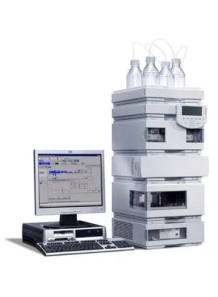HPLC Analysis of Niacin impurities in Niacinamide
- Product Code: 35536
Niacin impurity found in Niacinamide can cause flushing effect on skin. HPLC analysis service provide quantification of Niacin content in sample.
Niacin impurity found in Niacinamide can cause flushing effect on skin.
HPLC analysis service provide quantification of Niacin content in sample.
Protocol:
Sample Preparation:
1. Accurately weigh a known amount of the niacinamide sample.
2. Dissolve the sample in a suitable solvent, such as a mixture of water and methanol or acetonitrile, depending on the solubility of the sample.
3. Filter the solution through a membrane filter (e.g., 0.45 μm) to remove any particulate matter.
Chromatographic Conditions:
1. HPLC System: Use a high-performance liquid chromatography system equipped with a UV-Vis detector or a diode array detector (DAD).
2. Column: Select a reversed-phase C18 column (e.g., 4.6 mm × 250 mm, 5 μm particle size) or an equivalent column suitable for the separation of niacin and niacinamide.
3. Mobile Phase: Prepare a suitable mobile phase composition, typically a mixture of water and an organic solvent like methanol or acetonitrile. The mobile phase composition can be isocratic (constant composition) or gradient (varying composition over time).
4. Flow Rate: Adjust the flow rate according to the column dimensions and the desired analysis time, typically between 0.8 and 1.5 mL/min.
5. Detection Wavelength: Set the detection wavelength to a suitable value for niacin and niacinamide, typically around 260-270 nm.
6. Column Temperature: Maintain the column at a constant temperature, usually between 25°C and 35°C, to ensure consistent retention times and peak shapes.
Standard Solution Preparation:
1. Prepare standard solutions of niacin and niacinamide at different known concentrations in the same solvent used for sample preparation.
2. Filter the standard solutions through a membrane filter (e.g., 0.45 μm) before injection into the HPLC system.
Chromatographic Analysis:
1. Inject a suitable volume (e.g., 10-20 μL) of the filtered standard solutions into the HPLC system.
2. Record the retention times and peak areas for niacin and niacinamide in the standard solutions.
3. Construct a calibration curve by plotting the peak areas against the corresponding concentrations of the standards.
4. Inject the filtered sample solution into the HPLC system under the same chromatographic conditions as the standards.
5. Identify the peaks corresponding to niacin and niacinamide based on their retention times compared to the standards.
6. Quantify the niacin content in the niacinamide sample by comparing the peak area of niacin with the calibration curve.
| Step | Procedure | Expected Result | |||
|---|---|---|---|---|---|
| There is no item to display. | |||||
Niacin impurity found in Niacinamide can cause flushing effect on skin. HPLC analysis service provide quantification of Niacin content in sample.
Niacin impurity found in Niacinamide can cause flushing effect on skin.
HPLC analysis service provide quantification of Niacin content in sample.
Protocol:
Sample Preparation:
1. Accurately weigh a known amount of the niacinamide sample.
2. Dissolve the sample in a suitable solvent, such as a mixture of water and methanol or acetonitrile, depending on the solubility of the sample.
3. Filter the solution through a membrane filter (e.g., 0.45 μm) to remove any particulate matter.
Chromatographic Conditions:
1. HPLC System: Use a high-performance liquid chromatography system equipped with a UV-Vis detector or a diode array detector (DAD).
2. Column: Select a reversed-phase C18 column (e.g., 4.6 mm × 250 mm, 5 μm particle size) or an equivalent column suitable for the separation of niacin and niacinamide.
3. Mobile Phase: Prepare a suitable mobile phase composition, typically a mixture of water and an organic solvent like methanol or acetonitrile. The mobile phase composition can be isocratic (constant composition) or gradient (varying composition over time).
4. Flow Rate: Adjust the flow rate according to the column dimensions and the desired analysis time, typically between 0.8 and 1.5 mL/min.
5. Detection Wavelength: Set the detection wavelength to a suitable value for niacin and niacinamide, typically around 260-270 nm.
6. Column Temperature: Maintain the column at a constant temperature, usually between 25°C and 35°C, to ensure consistent retention times and peak shapes.
Standard Solution Preparation:
1. Prepare standard solutions of niacin and niacinamide at different known concentrations in the same solvent used for sample preparation.
2. Filter the standard solutions through a membrane filter (e.g., 0.45 μm) before injection into the HPLC system.
Chromatographic Analysis:
1. Inject a suitable volume (e.g., 10-20 μL) of the filtered standard solutions into the HPLC system.
2. Record the retention times and peak areas for niacin and niacinamide in the standard solutions.
3. Construct a calibration curve by plotting the peak areas against the corresponding concentrations of the standards.
4. Inject the filtered sample solution into the HPLC system under the same chromatographic conditions as the standards.
5. Identify the peaks corresponding to niacin and niacinamide based on their retention times compared to the standards.
6. Quantify the niacin content in the niacinamide sample by comparing the peak area of niacin with the calibration curve.
| Mechanism | - |
| Appearance | - |
| Longevity | - |
| Strength | - |
| Storage | - |
| Shelf Life | - |
| Allergen(s) | - |
| Dosage (Range) | - |
| Recommended Dosage | - |
| Dosage (Per Day) | - |
| Recommended Dosage (Per Day) | - |
| Mix Method | - |
| Heat Resistance | - |
| Stable in pH range | - |
| Solubility | - |
| Product Types | - |
| INCI | - |
Purchase History for
Cart
No products



